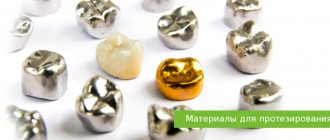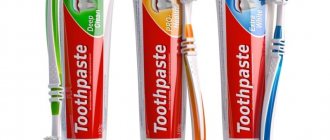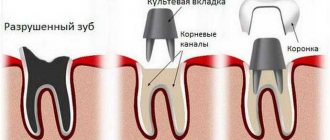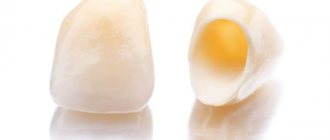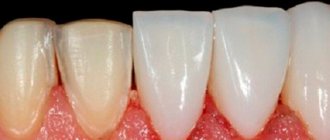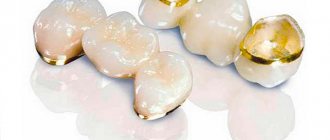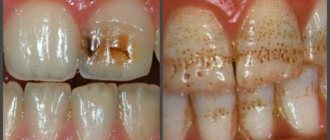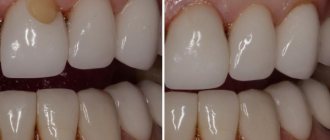What is the difference between a crown and a veneer?
Experts classify both crowns and veneers as orthopedic dentistry, which deals with dental prosthetics. If we talk about the purpose, then in the conventional orthopedic chain “crown-inlay-veneer” the last product is primarily intended to create aesthetics, while crowns and inlays are needed to primarily restore the functionality of the tooth. In dentistry, a separate category is allocated for veneers - microprosthetics, which well reflects the most important visual difference between veneers and crowns. A crown completely copies the entire visible part of a tooth, while veneers model only its outer (vestibular) side.
What veneers and crowns have in common is the fact that both are made in a dental laboratory, but this does not apply to direct composite onlays. In their case, the need for a laboratory stage is eliminated: the application of the composite material is carried out directly in the patient’s mouth, so the procedure does not require taking impressions and is considered an artistic restoration. As for manufacturing materials, there is great variability in crowns. Both designs can be produced from ceramics and zirconium dioxide. However, zirconium veneers are rarely used: zirconium does not adhere well to the teeth, requires significant grinding and looks unnatural.
Main differences
Both types of prostheses are used in orthopedic dentistry for prosthetic restoration of damaged elements.
Veneers are very thin sheets that are glued to the front surface of the damaged unit. They close the existing defect, so the smile begins to look aesthetically pleasing. However, they are not able to completely restore the functions of the tooth. They only replace its visible part to get a good visual result.
Dental crowns are restorations that cover the visible portion of an incisor/molar tooth. Outwardly, they resemble caps with thin walls. They are glued onto a previously prepared stump using special cement.
What is better - veneers or crowns?
Talking about which is better (veneers or crowns) is like comparing a car and a motorcycle. Each of these methods has its own advantages and indications for use. Below is a table that shows situations when it is most preferable to use crowns and when to use veneers.
| Indications for installation of veneers | Indications for crown installation |
|
|
By and large, crowns and veneers have different indications for installation, however, there are situations in which the patient can choose between two products.
Materials used in the manufacture of veneers.
Plates made from composite have an affordable price, but do not have high practical and aesthetic indicators, since they are made from filling materials. The main problem with such veneers is the rapid change in color due to sensitivity to various types of food coloring and the tendency to chip. Ceramic onlays have similar properties to ceramic crowns. These veneers are strong, but at the same time fragile. If you are in the habit of chewing seeds, crackers, or other similar loads, they may fly off or break. Ceramic veneers are more expensive than ceramic crowns, but having found financial opportunities, a person gets a dazzling, perfect smile.
When is the best time to install crowns?
- With significant tooth decay.
From a functional point of view, crowns are considered a more reliable method, so it is better to cover serious chips and damage with crowns. In addition, veneers are strictly not recommended for pulpless teeth. - Frequent participation in contact sports.
If you cannot imagine your life without hockey, basketball or martial arts, it is better to choose more durable crowns to restore your teeth. - Bruxism and the habit of chewing on foreign objects.
In this case, installing veneers is very risky, but even crowns are not able to withstand such loads for a long time, so you need to get rid of bad habits or consult a doctor to treat bruxism.
Photos before and after installation of veneers
How to choose materials?
When it comes to the restoration of anterior teeth, in addition to the functional characteristics of the structures, the aesthetic side of the issue must be taken into account. Aesthetics is directly related to the quality of the material, and it is believed that veneers are better than crowns in this regard. This is partly true, but with the right selection of material and design, crowns will also look natural and beautiful. There is only one problem when installing crowns: choosing the right shade of dentures in accordance with the adjacent teeth. The task becomes easier if you replace the entire set of teeth at once, because the structure is made of one material. Metal-ceramic crowns. They are very popular due to the price-quality ratio, but in terms of aesthetics they are far from perfect. Characteristics of metal-ceramic crowns.
- There is a cosmetic effect, but the difference next to natural teeth most often remains noticeable.
- Reliable, durable. They can withstand serious loads; chipping is possible only under very strong mechanical stress.
- Service life up to 10 years.
- Depulpation is necessary and the dental tissue is subjected to significant grinding.
- Quite a reasonable price.
There are also crowns made of metal-free ceramics: zirconium and porcelain. They are inferior to metal-ceramics in terms of strength, but have higher aesthetic values. If a person does not put heavy loads on ceramic prosthetic teeth, they will last about 10 years.
When is the best time to install veneers?
- For small defects in the front teeth.
Unlike crowns, veneers require minimal grinding of the teeth, so the tooth retains its anatomical shape. By the way, it is no longer possible to install veneers after crowns; - To hide small interdental spaces and curvatures.
Veneers cope well with such problems and do not require deep tooth preparation.
When restoring chewing teeth, crowns should be installed, as they cope well with the chewing load. Veneers are placed on molars if they want to get an additional lifting effect for the lower third of the face.
How are they different, help in choosing
Although both types of restoration visually create the same end result, they are very different in application. The most significant difference between veneers and crowns is the depth of treatment of enamel and dentin, because they are installed in different ways:
- crowns cover the entire tooth;
- veneers cover only the outer side (the one that is visible when a person smiles).
The tooth prepared for the prosthesis is greatly reduced in size and ground to a conical shape. The amount of reduction required is at least 2 mm (depending on the degree of damage). It is based on the fact that the standard crown wall thickness is 2 mm. However, this also depends on the type of materials. For example, metal ones are usually somewhat thinner.
When it comes to the benefits of veneers or ceramics, it is better to proceed from the facts, because they have an individual set of characteristics that are taken into account for the best choice. Pros and cons of crowns:
- Requires deep grinding.
- Due to the metal base they look less natural.
- Can be used to change color and shape more significantly.
- Used to restore and strengthen severely damaged teeth.
- Very strong, durable and the best choice for heavy chewing loads.
Crowns are used for large-scale restoration of severely damaged teeth. Veneers are usually used when minimal cosmetic interventions are required.
For example, they are used in the following cases:
- Used to change color (slight to moderate usually gives the most realistic results).
- You can slightly adjust the shape.
- Placed on healthy and undamaged teeth.
- Porcelain veneers most closely mimic natural teeth, but they are too fragile. They are usually installed in areas with relatively light and passive loads.
- Less traumatic, as they require little trimming; in some cases, they are installed without it.
- Once treated, a tooth will always need some type of coating.
Modern restoration materials meet the highest demands of beauty and functionality, although they have different structural characteristics. It is better to entrust the final decision in choosing between veneers or metal-ceramics to an experienced dentist, because the secret of an excellent result lies in his skillful hands, and an indicator of the perfection of technology is the natural and healthy appearance of teeth.
Are veneers used on crowns?
“Is it possible to put veneers on a crown?” — this question is so popular among patients that it has to be discussed separately. The answer here is obvious: veneers are NOT used on crowns. These products are self-sufficient, so such a “mix” makes no sense at all. Repair of crowns is possible, although replacement of the product is more often recommended. Crown restoration is carried out both in the laboratory (the crown is removed beforehand) and directly in the patient’s mouth. The whole procedure is reminiscent of a filling, when the damaged area is filled with a composite material. Veneers cannot be repaired: if the lining breaks, it is replaced with a new one. The exception is direct composite veneers, which can theoretically be restored.
Content
- What do crowns and veneers have in common?
- Main Differences
- What's better
Crowns and veneers belong to the section of dental prosthetics. Both types of constructions can serve to restore the aesthetics of the dentition. At the same time, veneers can correct mainly aesthetic defects, while crowns can restore damaged teeth. Crowns can also be used to eliminate cosmetic defects, but by and large, both technologies do not compete with each other. The tooth is damaged - there is a crown, there are minor flaws, problems with color or slight curvature of the teeth - the problem can be solved with the help of a veneer.
How are filled teeth prepared for veneers?
The standard preparatory procedure that the doctor performs before gluing veneers is a fine grinding of the front surface of the teeth so that the adhesive adheres better and the veneer plate itself holds more firmly. Along with the natural enamel, the filled parts of the surface of the patient’s teeth are also polished.
However, this is only possible if the fillings are stable and if they are made of high-quality, sandable material. There are several reasons why a dentist might suggest that a patient replace old fillings in their teeth with new ones.
- If secondary caries has developed under or next to the old filling. It is impossible to “hide” carious teeth under veneers, because this will significantly complicate the process of treating them in the future - anyway, then you will have to peel off the veneer, partially or completely destroy the old filling, put a new one, then re-attach the veneer... Therefore, at the slightest suspicion of caries, it is better to start treatment straightaway.
- If the filling is made of crumbling and abrasive material. Such a material could be dental cement, which is now practically not used in dental practice, but previously, for many decades in a row, people were given cement fillings in clinics. And now, when patients come to have veneers installed, dentists have to replace these outdated fillings with better ones - for example, photopolymer ones.
- If the filling is made of metal. This is, again, a filling technology rarely used these days, but due to their amazing durability and strength, metal fillings can stay in teeth for decades. They are replaced because the metal interferes with grinding and the fixing compound for the veneer is poorly attached to it.
- If the material from which the filling is made has darkened over time. This is because veneers (and, even more so, even thinner overlays - lumineers) have a very small thickness, and the material used to create them has a certain transparency. A veneer changes the shade of a tooth: for example, it can make a yellowish tooth snow-white - but a filling under the veneer that has become very gray or brownish will ultimately give the tooth a grayish tint.
The decision about whether a veneer can be applied to a specific tooth that has a filling, and what preparatory measures may be necessary for this, should only be made by a highly qualified dentist. Sometimes a visual examination of the dentition is not enough for the doctor to make a decision - and, for example, an X-ray examination of individual teeth is required.
The specialists of the VivaDent clinic offer patients a full range of dental and orthodontic services: professional examination of the condition of teeth and fillings in them, dental treatment and initial installation or replacement of fillings, production of veneers from various materials and high-quality fixation of them on the teeth.
